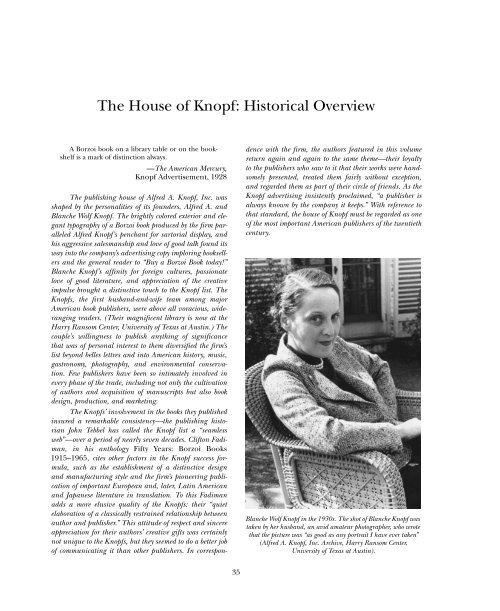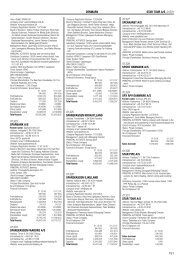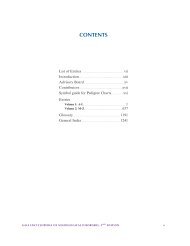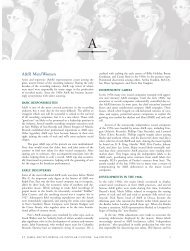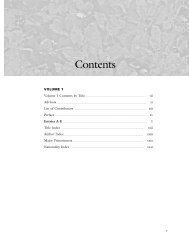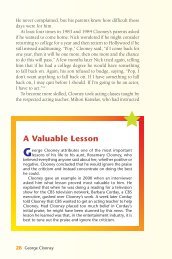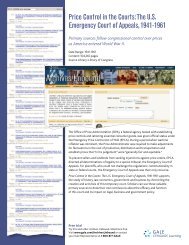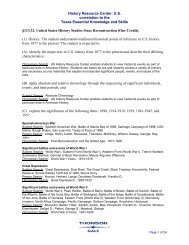Sample Pages - Gale
Sample Pages - Gale
Sample Pages - Gale
Create successful ePaper yourself
Turn your PDF publications into a flip-book with our unique Google optimized e-Paper software.
The House of Knopf: Historical Overview<br />
A Borzoi book on a library table or on the bookshelf<br />
is a mark of distinction always.<br />
—The American Mercury,<br />
Knopf Advertisement, 1928<br />
The publishing house of Alfred A. Knopf, Inc. was<br />
shaped by the personalities of its founders, Alfred A. and<br />
Blanche Wolf Knopf. The brightly colored exterior and elegant<br />
typography of a Borzoi book produced by the firm paralleled<br />
Alfred Knopf’s penchant for sartorial display, and<br />
his aggressive salesmanship and love of good talk found its<br />
way into the company’s advertising copy imploring booksellers<br />
and the general reader to “Buy a Borzoi Book today!”<br />
Blanche Knopf’s affinity for foreign cultures, passionate<br />
love of good literature, and appreciation of the creative<br />
impulse brought a distinctive touch to the Knopf list. The<br />
Knopfs, the first husband-and-wife team among major<br />
American book publishers, were above all voracious, wideranging<br />
readers. (Their magnificent library is now at the<br />
Harry Ransom Center, University of Texas at Austin.) The<br />
couple’s willingness to publish anything of significance<br />
that was of personal interest to them diversified the firm’s<br />
list beyond belles lettres and into American history, music,<br />
gastronomy, photography, and environmental conservation.<br />
Few publishers have been so intimately involved in<br />
every phase of the trade, including not only the cultivation<br />
of authors and acquisition of manuscripts but also book<br />
design, production, and marketing.<br />
The Knopfs’ involvement in the books they published<br />
insured a remarkable consistency—the publishing historian<br />
John Tebbel has called the Knopf list a “seamless<br />
web”—over a period of nearly seven decades. Clifton Fadiman,<br />
in his anthology Fifty Years: Borzoi Books<br />
1915–1965, cites other factors in the Knopf success formula,<br />
such as the establishment of a distinctive design<br />
and manufacturing style and the firm’s pioneering publication<br />
of important European and, later, Latin American<br />
and Japanese literature in translation. To this Fadiman<br />
adds a more elusive quality of the Knopfs: their “quiet<br />
elaboration of a classically restrained relationship between<br />
author and publisher.” This attitude of respect and sincere<br />
appreciation for their authors’ creative gifts was certainly<br />
not unique to the Knopfs, but they seemed to do a better job<br />
of communicating it than other publishers. In correspondence<br />
with the firm, the authors featured in this volume<br />
return again and again to the same theme—their loyalty<br />
to the publishers who saw to it that their works were handsomely<br />
presented, treated them fairly without exception,<br />
and regarded them as part of their circle of friends. As the<br />
Knopf advertising insistently proclaimed, “a publisher is<br />
always known by the company it keeps.” With reference to<br />
that standard, the house of Knopf must be regarded as one<br />
of the most important American publishers of the twentieth<br />
century.<br />
Blanche Wolf Knopf in the 1930s. The shot of Blanche Knopf was<br />
taken by her husband, an avid amateur photographer, who wrote<br />
that the picture was “as good as any portrait I have ever taken”<br />
(Alfred A. Knopf, Inc. Archive, Harry Ransom Center,<br />
University of Texas at Austin).<br />
35
The House of Knopf: Historical Overview DLB 355<br />
This photograph of Alfred A. Knopf was taken in his office in the 1930s, probably for an article in Publishers’ Weekly<br />
(Alfred A. Knopf, Inc. Archive, Harry Ransom Center, University of Texas at Austin).<br />
The Knopfs’ Early Years<br />
Born 12 September 1892 to Samuel and Ida Japhe<br />
Knopf, Alfred A. Knopf grew up in a privileged household<br />
in New York, headed by his father, a wealthy advertising<br />
man of Russian Jewish extraction. His mother, who may<br />
have committed suicide, died when he was four years old.<br />
In 1908 Knopf entered Columbia College, where he was<br />
bored by most of his classes but inspired by a few professors,<br />
including Joel E. Spingarn, who prompted Alfred to begin<br />
collecting books. There were early signs of the boldness that<br />
later led to his success in business. Assigned to write an<br />
essay on a contemporary author, Knopf began a correspondence<br />
with John Galsworthy. Following his graduation in<br />
1912, he visited Europe and met with Galsworthy, who recommended<br />
the writers W. H. Hudson and Joseph Conrad—both<br />
played a role in Knopf’s earliest publishing<br />
ventures. Knopf also visited bookstores throughout<br />
England and Europe, noting the aesthetic appeal of certain<br />
books and choosing favorite publishers. By the end of<br />
the summer he said, “I came home . . . determined to be a<br />
publisher and not a lawyer as the family had intended.”<br />
Following a stint as an advertising salesman for<br />
The New York Times, Knopf was hired as an accountant<br />
by Doubleday, Page in 1912. He soon managed to<br />
involve himself in every phase of the publishing enterprise.<br />
Because of his familiarity with Conrad, he was<br />
one of the first to read the manuscript of Chance.<br />
Enthusiastic about the novel and displeased with Doubleday’s<br />
lackluster promotion, Knopf wrote to the most<br />
prominent authors of the day requesting testimonial<br />
blurbs, which were compiled into a promotional pamphlet,<br />
published in 1913, that contributed to the sale of<br />
50,000 copies of Chance. Knopf’s enthusiasm for Conrad<br />
led him to form a bond with the iconoclastic journalist<br />
H. L. Mencken, also a Conrad admirer.<br />
In March 1914 Knopf left Doubleday to join the<br />
English-born publisher Mitchell Kennerley as an assistant,<br />
in part because of his admiration for Kennerley’s<br />
commitment to good book design. Knopf honed his publicity<br />
skills and “traveled” for the firm—making important<br />
contacts as he sold Kennerley books to booksellers.<br />
His Kennerley days ended abruptly when the publisher<br />
discovered that his twenty-three-year-old employee was<br />
36
DLB 355<br />
The House of Knopf: Historical Overview<br />
about to found his own publishing company and<br />
planned to take a Kennerley author, the popular novelist<br />
Joseph Hergesheimer, along with him.<br />
Blanche Wolf was born in New York 30 July 1894<br />
to Julius and Bertha Wolf. Like her future husband,<br />
Blanche was from an upper-class background (the<br />
Wolfs considered themselves socially superior to the<br />
Knopfs). She was educated privately and graduated<br />
from the Gardner School. She met Alfred A. Knopf in<br />
1911 and, along with his father, encouraged him to<br />
start his own publishing firm. They were married 4<br />
April 1916, while Alfred was still drawing only $25<br />
dollars a week from the company.<br />
* * *<br />
In these excerpts from his memoirs Alfred Knopf<br />
recalls his life growing up in New York and his marriage to<br />
Blanche Wolf.<br />
“Onward and Upward”<br />
Alfred A. Knopf<br />
I was born in New York at what was then 234<br />
Central Park West, September 12th, 1892. My<br />
father, Samuel, was born thirty years earlier in<br />
Russian Poland. The only boy in a family of six<br />
children, he was brought to New York at an early<br />
age. My mother, Ida Japhe, of whom my father<br />
apparently found it difficult to speak, died, I think<br />
a suicide, when I was very young and I have no<br />
memory of her. But in 1949, after Geoffrey Hellman’s<br />
Profile of me appeared in The New Yorker, a<br />
lady, a stranger, wrote me that she had been in<br />
1887-8 in a class my mother taught at a public<br />
school. The letter continued: “She was a splendid<br />
teacher. Not only did she know her subject thoroughly,<br />
but she had that wonderful facility of<br />
being able to impart it to the immature mind. I<br />
loved her. When you were about one year old,<br />
your mother wanted me to see her baby. One of<br />
the things I remember you did was to open your<br />
father’s box of cigars, take one out and proceed to<br />
break it. Your mother said it was perfectly all<br />
right, the cigar cost only fifty cents (father always<br />
had a taste for fine cigars) and you would break a<br />
fifty cent toy just as quickly. You evidently had a<br />
taste for cigars at an early age.” . . .<br />
I have a few memories of my early childhood, but<br />
one stands out clearly--walking with a Negro manservant<br />
along the bluff overlooking a river and I think this<br />
must have been in Cincinnati about 1895 when my<br />
father was in business there.<br />
Alfred Knopf as a young man (Alfred A. Knopf, Inc. Archive,<br />
Harry Ransom Center, University<br />
of Texas at Austin)<br />
Around the turn of the century we moved to<br />
what for us was the City--a three story and basement<br />
house on the East Side of Convent Avenue<br />
just below 148th Street . . .<br />
We were a mixed-up family by [1901].<br />
There was my sister Sophia, Elizabeth, a stepsister,<br />
child of my stepmother by her first marriage<br />
and several years older than the rest of us, and<br />
my half brother Edwin, who was born in 1899.<br />
The reader can imagine how badly at times such<br />
an assortment got along with one another. But<br />
on the whole I spent my time with other boys<br />
though I can only remember the Blacks who<br />
lived across the street . . . , the Perines who lived<br />
next door to the south and Julian Marx whom we<br />
didn’t much like. But there must have been oth-<br />
37
The House of Knopf: Historical Overview DLB 355<br />
ers for we spent many an afternoon chasing and<br />
being chased by ‘gangs’ of what we called ‘micks.’<br />
I am not too clear about the exact order of<br />
my schooling. I think I went for a while to Public<br />
School #46 at 156th Street and St. Nicholas Avenue.<br />
Then a brief spell at Horace Mann where I<br />
developed kleptomania and stole—yes—books.<br />
When, before long, I was found out, Father managed<br />
somehow to remove me from the school<br />
without any publicity and then enrolled me at P.S.<br />
#186 on 145th Street, east of Broadway. There was<br />
a branch of the Public Library next door. I frequented<br />
it and another branch on St. Nicholas<br />
Avenue near 155th Street . . . In that way I discovered<br />
Conan Doyle, and Sherlock Holmes remains<br />
to this day the only wholly satisfying detective I<br />
have ever read about . . .<br />
Father must have been prospering in those<br />
days because we lived well. However, I don’t<br />
remember what his business was at the time and<br />
it may be that by present-day standards his<br />
income was very modest. Consider the house in<br />
which the six of us lived, with a cook, a chambermaid-waitress-laundress<br />
and a governess. The help<br />
was almost always Irish, but one governess was a<br />
Danish lady of distinguished presence who dined<br />
with the family. . . .<br />
We went to the country every summer.<br />
Except for one season on the Jersey coast, we were<br />
usually in Far Rockaway on the south shore of<br />
Long Island . . . Alfred Stieglitz summered not far<br />
away and toward sunset used to come tramping<br />
down the road with his wife (she was related by<br />
marriage to my stepmother) both carrying his<br />
camera, tripod and other equipment. . . .<br />
We observed only the Jewish Holy Days,<br />
though on the Day of Atonement, a solemn day of<br />
fasting for Jews who took the faith really seriously,<br />
we children were always taken to the Plaza for<br />
lunch which sort of made up for the boredom of<br />
the services. Most reformed Jews were no longer<br />
religious in a formal sense. I first went to Temple<br />
Israel of Harlem, Maurice Harris, Rabbi, and my<br />
only recollection is of hearing John D. Rockefeller<br />
for the first time. The good teacher impressed on<br />
us that though he was the world’s richest man, he<br />
had to live on a diet of crackers and milk. Later<br />
Father joined the much more fashionable Congregation<br />
of Temple Beth-El at 76th Street and Fifth<br />
Avenue and there, though we spent much time<br />
running three-legged races in the basement with<br />
the son of the Rabbi, Samuel Schulman, as the<br />
ringleader, I must have learned something for I<br />
was confirmed, had to make some kind of a talk in<br />
the Temple and was awarded a silver medal. Later,<br />
onward and upward as the New York Jewish bourgeoisie<br />
usually moved, we worshipped at Temple<br />
Emanu-El, first at 43rd and now at 66th Street on<br />
Fifth Avenue. One could go no higher. (Later<br />
Beth-El was torn down and in June 1932 when<br />
Father was buried from Emanu-El old Dr. Schulman<br />
delivered the Eulogy.) . . .<br />
* * *<br />
At Columbia University, Alfred Knopf enrolled in<br />
one of Spingarn’s final classes. Author of A History of<br />
Literary Criticism in the Renaissance (1899) and<br />
The New Criticism (1911), Spingarn taught at<br />
Columbia from 1899 to 1911 and went on to become<br />
one of the first white leaders of the National Association<br />
for the Advancement of Colored People.<br />
Knopf wrote a prize-competition essay on Galsworthy’s<br />
works that he sent to Galsworthy, sparking a lifelong<br />
correspondence and friendship. Galsworthy never<br />
published with Knopf but was helpful to the aspiring<br />
publisher early on in Knopf’s career.<br />
John Galsworthy to Alfred A. Knopf,<br />
15 February 1911<br />
Dear Mr. Knopf<br />
Thank you very warmly for your letter and<br />
the copy of your essay. It was most interesting to<br />
read and is surely quite a remarkable effort for<br />
your age. Of course there are differences of judgement<br />
between us, but I think you are right in placing<br />
‘The Man of Property’ and ‘Fraternity’ at the<br />
top of the novels. I don’t know whether I agree<br />
that ‘Justice’ is superior to ‘Strife’; it is in spirit, I<br />
think, but is not the equal of ‘Strife’ in its dramatic<br />
quality—<br />
I am glad you speak well of the short things,<br />
or rather, I am glad you like them.<br />
I don’t agree that your style is “rather<br />
wretched”; it is clear, terse, and manages to say<br />
what you want to say. If your essay does not<br />
receive its reward, it will be, I think, because you<br />
have rather overdone the description of plot and<br />
quotation in proportion to analysis of spirit,<br />
style, and mood; but I hope very sincerely it will<br />
get you the prize. Anyway, it has given me much<br />
pleasure.<br />
Yours very truly<br />
John Galsworthy<br />
38
DLB 355<br />
The House of Knopf: Historical Overview<br />
A 1912 letter from John Galsworthy to Alfred Knopf, following through on the author’s suggestion that Knopf should pursue the<br />
American publication of W. H. Hudson (Alfred A. Knopf, Inc. Archive, Harry Ransom Center,<br />
University of Texas at Austin)<br />
39
The House of Knopf: Historical Overview DLB 355<br />
Alfred A. Knopf, Inc.<br />
With seed money from Samuel Knopf, the firm of<br />
Alfred A. Knopf, Inc. began its existence in May 1915, a<br />
couple of months after Alfred and Blanche’s engagement,<br />
with the publication of Émile Augier’s Four Plays. Ten<br />
other titles appeared during Knopf’s first year. The firm’s<br />
headquarters were located in one room at 220 West 42nd<br />
Street in Manhattan. From the outset the Knopf list<br />
included a large proportion of foreign authors, especially<br />
French and Russian ones, in part because it was relatively<br />
easy to obtain their American rights and production costs<br />
were kept low by using English sheets instead of resetting<br />
text. Borzoi Books, as they were named because of Blanche’s<br />
short-lived attachment to the dog breed, featured decorated<br />
bindings, eye-catching dust jackets, and tasteful typography.<br />
In summer 1918 Alfred became president of the firm,<br />
a newly created title he held for thirty-nine years.<br />
* * *<br />
In these excerpts from his memoirs Knopf recalls the<br />
early years of his publishing house and his marriage to<br />
Blanche, including the birth of their only child, Pat, in<br />
1918.<br />
“Not Doing Too Well”<br />
Alfred A. Knopf<br />
. . . Blanche and I finally felt we could risk marriage,<br />
and on the sixteenth of April, 1916, we were<br />
married at the St. Regis, which still had a beautiful<br />
suite on the second floor which overlooked Fifth<br />
Avenue. The good hotels had not yet found it economically<br />
necessary to rent their best fronts to retail<br />
stores. Indeed, the St. Regis has left this room<br />
exactly as it was in 1915, and in 1965 the Chevaliers<br />
de Tastevin held one of their dinners in it. There was<br />
a large attendance at the ceremony and the elegant<br />
luncheon which followed was attended by friends of<br />
the family and relatives, with only a sprinkling of our<br />
own friends, because we were really only interested<br />
in ourselves and the world of books and music. The<br />
ceremony was performed by a city magistrate, Alexander<br />
H. Geismar, who had married a niece of my<br />
father. He had started out as a rabbi but soon lost his<br />
religious convictions and went into politics. We had<br />
a high regard and affection for him, and in any case<br />
did not want a religious ceremony.<br />
We believed that we should support ourselves<br />
and that we could manage on the seventy-five dollars<br />
a week the business could probably pay me.<br />
On this basis we believed we could afford to<br />
pay seventy-five dollars a month for rent and spent<br />
Alfred Knopf in 1915, the year of the firm’s founding<br />
(photograph by E. O. Hoppé; Alfred A. Knopf, Inc.<br />
Archive, Harry Ransom Center, University<br />
of Texas at Austin)<br />
some weeks before the wedding house-hunting in<br />
Westchester. We found one that suited us but not the<br />
family, and as a result Blanche’s parents insisted on<br />
buying and furnishing a very attractive small house<br />
for us in Greenacres, a newish development in<br />
Hartsdale. . . .<br />
We kept house with a maid-of-all-work to whom<br />
we paid very modest wages, and we entertained a lot.<br />
Authors came up from the city for lunch or dinner<br />
or weekends and often stayed overnight. Later, when<br />
America entered the war, the help problem became<br />
acute and we ended with an unmarried mother from<br />
the Bedford Reformatory whose child delighted<br />
Blanche and our friends by always calling me<br />
“Dada”. We got ourselves the first of two real Borzois—the<br />
most undoggy dogs I have ever<br />
known—and one day a fellow turned up at the office<br />
with a mongrel bull he wanted to sell for fifteen dollars.<br />
I bought him, and Pete remained our devoted<br />
pal until we moved to the city in the fall of 1918.<br />
Then we gave him to Pendleton and Hermine Dudley<br />
in Pleasantville where he became a town character.<br />
He usually hung around a traffic officer, was<br />
thrown more than once by a locomotive, but lived,<br />
40


